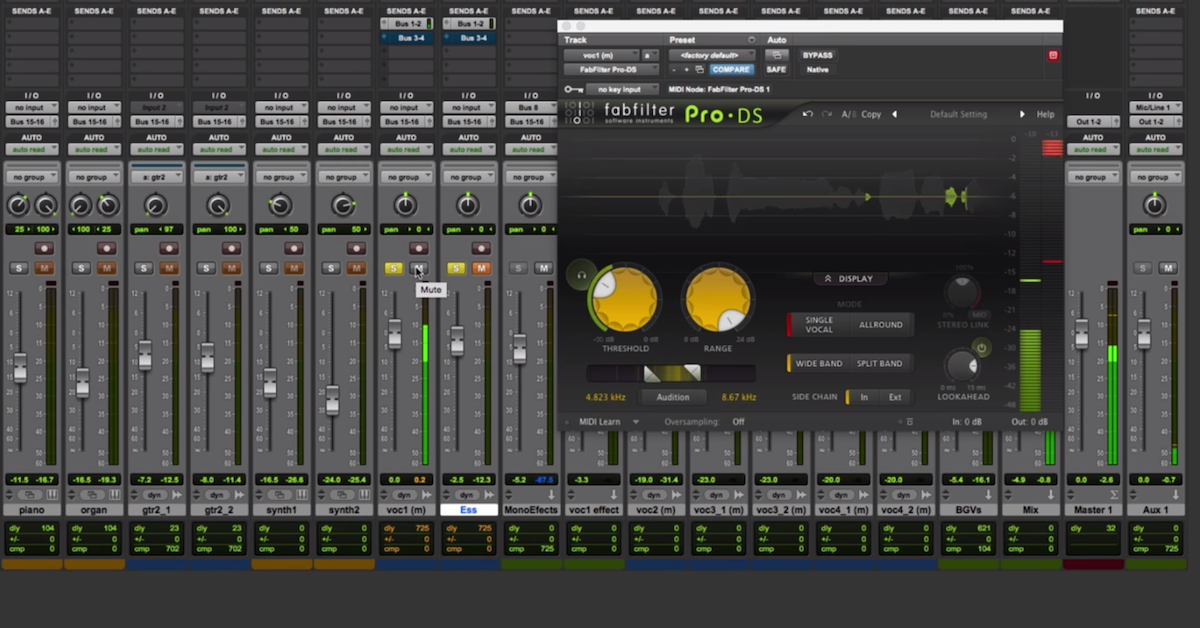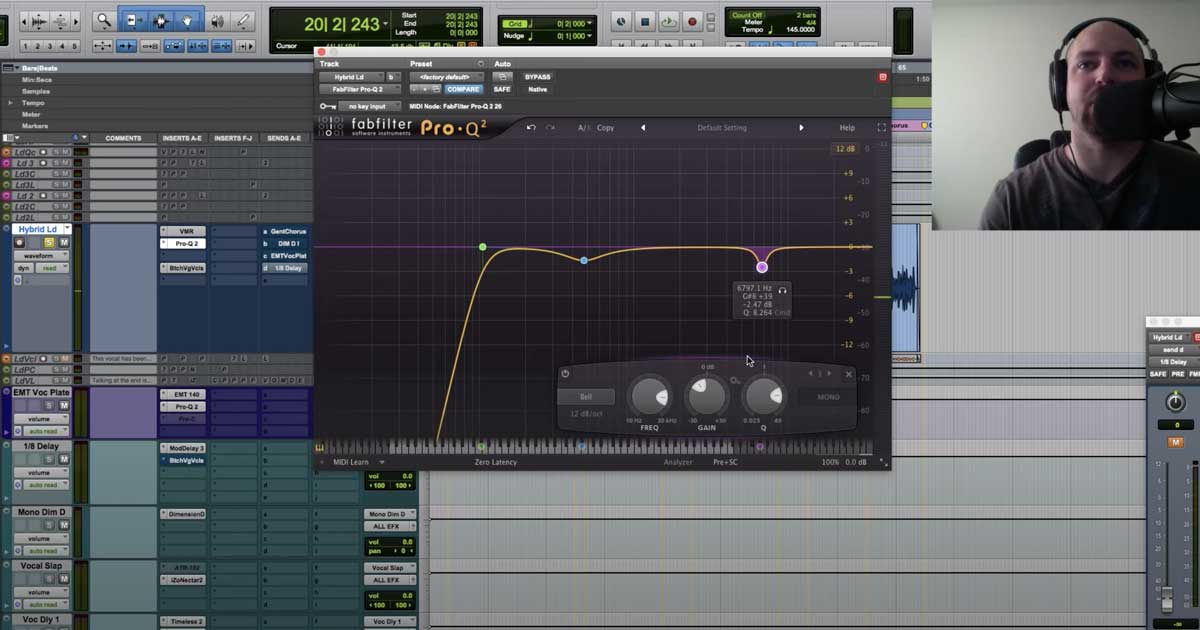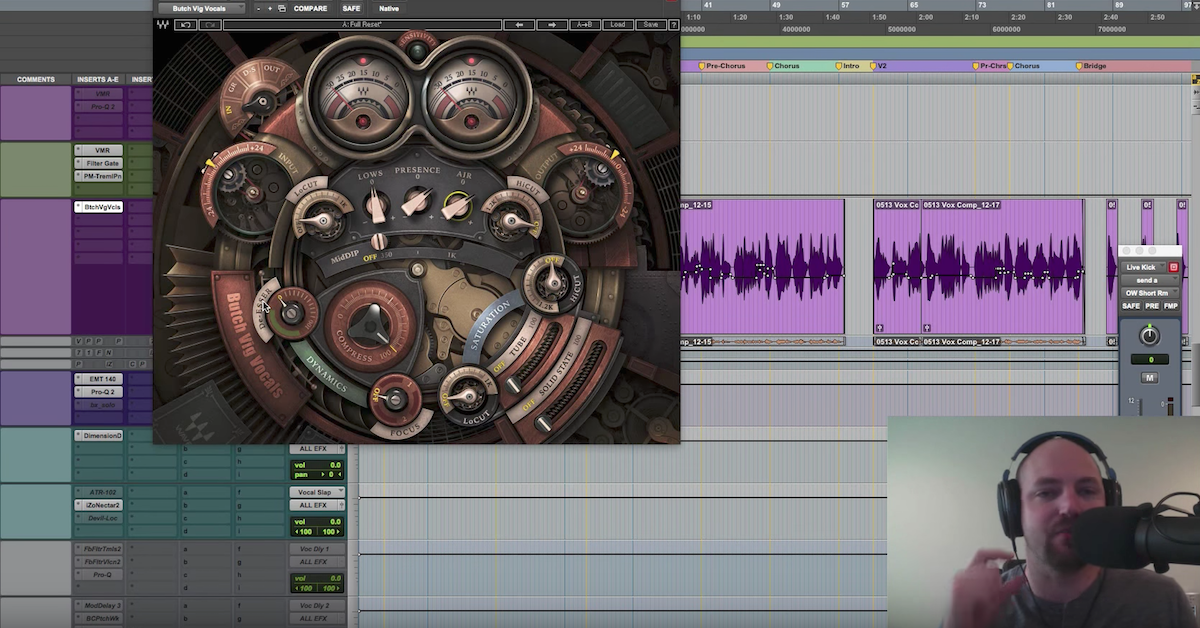Tips for Mixing Rock Vocals
Article Content
I want to talk about how to approach mixing vocals in a Hard Rock song. I’ll be the first to say that there’s a ton of great resources floating around the internet on this subject, but I’d like to throw my hat into the ring.
Hard Rock is a pretty broad category — containing Punk, Pop-Punk, Garage, some styles of Alt-Rock, Grunge, Hardcore, about 25 billion sub-genres of Metal — you get the point. Every genre, style, and song within a genre is going to have its own nuances.
Rather than try to spoon feed a bunch of techniques, I’m going to discuss the approach to vocal treatment, what should be considered, and then go over a few techniques that might help reach the goals of your vocal sound.
What Do You Want to Convey?
I think the best place to start is by figuring out where you ultimately want to end up. The most important question is: what do I want this vocal to convey? Because some vocals are meant to sound anthemic, like you’re in an arena with ten thousand people, and other vocals are supposed to sound like you’re in a small, dank bar with a janky PA system. I like to envision the space, and I also like to create a subjective scale for how “engineered” the vocal should sound.
Pop-Punk records usually want to sound a bit done up — it should sound like a natural voice — but a stellar capture of that natural voice. Whereas with a Grunge record, I’m really looking to do as little treatment as possible. It’s a style that has no qualms admitting that it’s a recording, and you get everything you get from that.
Metal genres are often heavily effected, but should be done so to the end result of sounding exceptionally aggressive. The more adjectives I can staple on to the idea of the sound, the more deliberate my vocal processing (or choice of not processing) can be.
Balance
One of the common threads in heavier Rock genres is that the vocal isn’t always the star of the show. There was about a five year period in the early 90s where you could not understand the words to any songs playing on the Rock FM station, unless it was Sublime or Chili Peppers. The guitars often take precedence in the mix, and the snare drum is usually pretty competitive as well.
Of course, sometimes the vocal is the star of the show, and this may very well change from section to section. It’s not uncommon for the verse to be “smaller” and more vocal-centric, and the chorus to lay in with extra guitar layers and more driving drums.
We have to assign what our biggest elements are going to be. Once we have that assignment, it is extremely important to approach our vocals in the context of competing elements. The solo button is not your friend. The solo button is something that you wronged in the past and is now coming for your blood.
This is probably the biggest distinction between Hard Rock genres, and say, Hip-Hop or Pop. The latter are vocal-centric, and the music moves around the perfect vocal sound. In these Rock genres, the vocal has to meet and live within a world where the guitars and drums may take center stage. This concept will be a recurring theme in this article.
Tone
Tone shaping is probably the most challenging aspect of treatment. However, if we know ultimately what we want from the vocal, our treatment becomes a lot clearer. It’s impossible to describe the infinite scenarios of how to shape the tone of a vocal, but I’ll go over a few key points.
Top End
It’s very rare in any style of Hard Rock that we want a shimmery, angelic top end. That’s better suited for Pop and R&B. So when I’m looking for a brighter vocal, instead of thinking 10kHz+ (that shiny, glittery range), I’m thinking of 5k-8k. This is a more assertive, edgy range of treble. And I’m rarely looking to accentuate that range any more than necessary unless I’m doing like a Pop-Punk kind of thing.
Playing up the treble is really only if the vocal needs to float above bright guitars, or if the treble was deficient to begin with. Often enough I’m just looking to have a balanced top end (turning the treble down if the capture is bright, turning it up if it was dark), and the real presence is going to come through the midrange of the vocal.
Midrange
This is usually going to be the focal point of my vocals. The midrange sort of divides into two categories: the “cutting” midrange, which is around 1-4kHz, and the heavy midrange, which is that 300Hz-1k zone. For more aggressive styles — Death Metal, Hardcore, etc. — I generally want that cutting midrange to be the focus. This is the range that helps the vocal be heard through heavy guitars.
For darker styles of Heavy Rock, I’m probably going to focus more on that lower midrange, and simply have the vocal a bit louder in the overall mix so it competes. What’s important to note is that in solo the vocal will often sound overly midrangey or overly “woolly”, but once the bass and guitars are in, the vocal sounds just right. Solo mode hates you and tells you lies.
Cleanup
The last consideration is how “clean” I want a vocal to sound.
That lower midrange can be tricky. A lot of what we hear in there is proximity build up and room tone — stuff that we traditionally call “mud.” Unfortunately that same range is also the body of the voice and dimensionality of the recording.
My recommendation is to focus on broad tone shaping first, and save any kind of cleanup for after we’ve done our dynamic processing and to do the cleanup with our guitars and bass playing. That mud stuff might not need as much attenuation as you initially expect.
Dynamics
I tend to favor a very heavily compressed sound for my vocals in most styles of Hard Rock. I handle my dynamics in stages in order to get this right. The first thing I do is regular ol’ volume automation or region editing. Even if I want the vocal to be quieter in some places and louder in others I still want the vocal feeding the compressor to be evened out.
I want my compressor to be acting on my vocal in a uniform way. I automate the vocal to be consistent in level, and then feed the vocal into my compressor, I apply my compression, then I automate the vocal again to create the appropriate variations within the section.
In terms of the actual degree of compression, I find it generally works best if it’s proportionate to the density of the mix. When we’re in a quiet, open section, little to no compression is fine. When the guitars are in full effect and the drums are bashing away we might need a lot of compression.
In addition, I find that Rock tends to be (shocker) very accepting of distortion. So even if I’m really crunching my vocals it’s usually ok. If we’re talking a real wall of guitars, I may even incorporate a second compressor either in serial or parallel and sometimes even a limiter as well.
Ambience
I tend to find that drier is better most of the time. Unless we’re going for that “stadium” sound. More often than not though I’m using (a) a very short room tucked subtly, (b) a tight slap back delay, or (c) no ambience at all. Reverb tends to make things sound too produced and polished.
Now to completely contradict what I just said, sometimes a song or song section does seem to call for a prominent reverb and I find the solution to not making the vocal sound “overproduced” is to swing in the other direction. I’ll make the reverb pretty heavy. I tend to choose chamber or plate reverbs in these instances, halls just ultimately end up sounding too pretty and rooms tend to not have the “vibe” factor going on.
Special FX
I have a pet peeve. Cliche vocal distortion effects sound super lame. I guess at one point, running the vocals through some kind of distortion effect sounded unique and edgy, but now it kind of sounds like self-parody. I’m not opposed to doing it. The opposite really, I love unique effects. I’m just picky about making it work. I want distortion or really any special effects to sound like a natural extension of the feel of the song, and not like a “hey, this is Rock, so I used distortion, rawr!” kind of thing.
There isn’t really a guide to when vocal distortion sounds predictable vs. when it sounds inspired. It’s just feel.
One suggestion I can make is to look for distortion in places you wouldn’t normally think to get it. And I’ll leave it at that.
Bringing It All Together
The key to all of this is to make the vocals work with the other instruments playing. I find Rock vocal processing to be assertive, creative, fun … It should be a bit balls to the wall.
What it shouldn’t do is sound out of context.
There aren’t really “rules” the same way there are “rules” in Pop or R&B or commercial Hip-Hop, but there’s still an aesthetic of musicality and the rest of the instrumentation will guide that.





